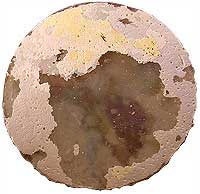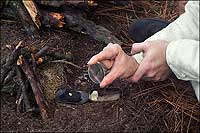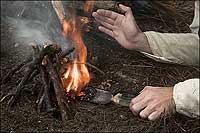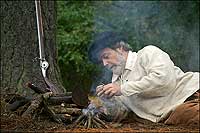Of Lenses and Tinderboxes
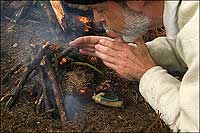
D. A. Saguto, portraying a seventeenth-century settler, coaxes the flame he started with a burning lens, most likely what archaeologists found at Jamestown, below.
Archaeologists who recovered it from a plow zone context within the triangular palisaded fort place the lens with objects dated to the first half of the seventeenth century. The plano-convex—one side flat, the other curved—lens was too encrusted with debris to test, but given its dimensions we were able to replicate its basic optical properties. We calculated a focal length of 225mm, or about 9 inches, give or take 35mm, depending on the index of refraction of the glass used. Pretty short for a telescope of that era. A typical Galilean telescope would have had a focal length between 30 and 40 inches. The Jamestown example measures an ultra-short 18 inches. It would have consisted of a plano-convex objective—the lens nearest the object—and an ocular of about two inch focal length at the other end of an adjustable tube to place the object in focus.
The short focal length and solitary context of the find (there were no other telescope parts unearthed in the vicinity) make it more likely that the Jamestown lens was a burning glass. They have been known since antiquity. Aristophanes mentions one in his play The Clouds, written in 424 b.c. Burning glasses were typically five to ten power lenses that could be used on sunny days to ignite tobacco or tinder. One would usually carry the flammables in a tinderbox, the lid often fashioned to contain a compartment that housed the lens.
Burning glasses are listed among ship's cargo in Volume One of his The True Travels, Adventures, and Observations of Captaine John Smith in a passage about what Virginia's Indians thought of English equipments:
Most things they saw with us as Mathematicall Instruments, Sea-Compasses; the virtue of the Loadstone, Perspective Glasses, burning Glasses: Clocks to goe of themselves; Bookes, writing, Guns, and such like; so far exceeded their capacities, that they thought they were rather the workes of gods than men; or at least the gods had taught us how to make them, which loved us so much better then them; & caused many of them give credit to what we spake concerning our God.Lodestones have magnetic properties. Perspective glasses are magnifying glasses.
Smith also refers to the manufacturing of glass in Jamestown—indeed the glassworks of 1608 have been recreated at the original spot—and to shipments of such glass from the colony to England.
—Anthony Aveni and Roger Williams

